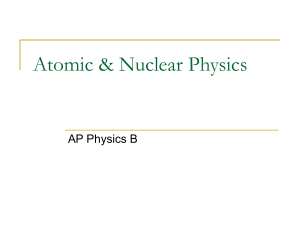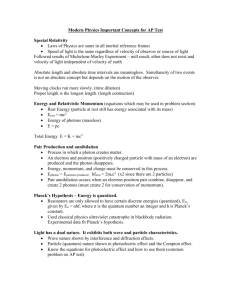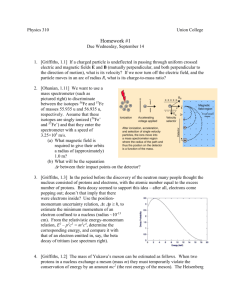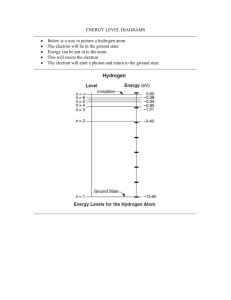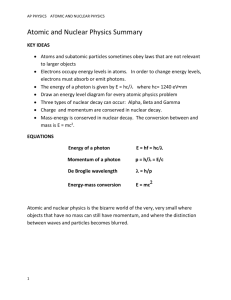Topic 12 Problem Set 2016
advertisement
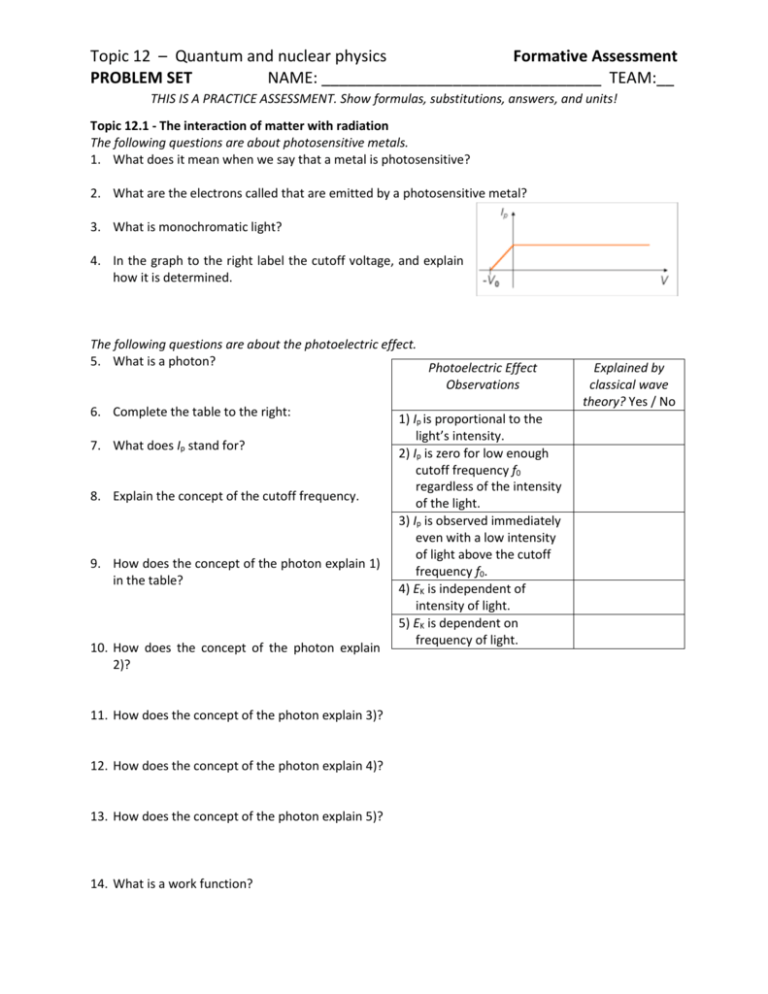
Topic 12 – Quantum and nuclear physics Formative Assessment PROBLEM SET NAME: ________________________________ TEAM:__ THIS IS A PRACTICE ASSESSMENT. Show formulas, substitutions, answers, and units! Topic 12.1 - The interaction of matter with radiation The following questions are about photosensitive metals. 1. What does it mean when we say that a metal is photosensitive? 2. What are the electrons called that are emitted by a photosensitive metal? 3. What is monochromatic light? 4. In the graph to the right label the cutoff voltage, and explain how it is determined. The following questions are about the photoelectric effect. 5. What is a photon? Photoelectric Effect Observations 6. Complete the table to the right: 7. What does Ip stand for? 8. Explain the concept of the cutoff frequency. 9. How does the concept of the photon explain 1) in the table? 10. How does the concept of the photon explain 2)? 11. How does the concept of the photon explain 3)? 12. How does the concept of the photon explain 4)? 13. How does the concept of the photon explain 5)? 14. What is a work function? 1) Ip is proportional to the light’s intensity. 2) Ip is zero for low enough cutoff frequency f0 regardless of the intensity of the light. 3) Ip is observed immediately even with a low intensity of light above the cutoff frequency f0. 4) EK is independent of intensity of light. 5) EK is dependent on frequency of light. Explained by classical wave theory? Yes / No 15. In the mathematical formulation of the photoelectric effect, hf = + EK,max describe what each part of the equation represents, in terms of work and energy. 16. Describe and explain an experiment to test the Einstein model of the photoelectric effect. Include a sketch of the apparatus. The following questions are applications of the photoelectric effect. 17. A photosensitive metal has a work function of 3.75 eV. Find the minimum frequency of light needed to free an electron from its surface. 18. If a photon having a higher frequency than the one determined in the previous problem strikes the metal, where will the excess energy go? 19. A photosensitive metal has a work function of 3.75 eV. Find the maximum kinetic energy of an electron freed by a photon having a frequency of 2.501016 Hz. The following questions are about matter waves. 20. What is meant by the term “wave-particle duality” and to what is it applied? 21. What is a matter wave? 22. State the de Broglie hypothesis, and then write its mathematical formula. 23. Present an outline of the Davisson-Germer experiment and how it verified the de Broglie hypothesis. The following questions are applications of the de Broglie hypothesis. 24. An electron is accelerated from rest through a potential difference of 275 V. What is its expected de Broglie wavelength? 25. A particle has an energy E and an associated de Broglie wavelength . Show that the energy E is proportional to -2. The following questions are about the structure of the atom. 26. Outline a laboratory procedure for producing and observing atomic spectra. 27. Explain how atomic spectra provide evidence for the quantization of energy in atoms. For the following questions refer to the diagram to the right. 28. What is the frequency of a 656 nm hydrogen emission spectrum line? 29. What is the energy in J and eV of the photon from 28? 30. What are the energy levels associated with this photon? The following questions cover derivations leading up to the Bohr model of the hydrogen atom. 31. Using Coulomb’s law for a proton and an electron and the fact that this force is centripetal in nature, show that mv2 = ke2/r for an electron with orbital radius r. 32. Using the results from 31 and the definition of mechanical energy E = EK + EP, show that the total mechanical energy of a hydrogen atom is given by E = – (1/2)ke2/r. The following questions are about the Bohr model of the hydrogen atom. 33. What assumptions did Bohr make when developing his theory of the structure of the hydrogen atom? 34. Write the relationship between angular momentum L and momentum p = mv for an electron orbiting a hydrogen nucleus at a radius of r. 35. Write the assumption Bohr made for angular momentum in formulaic form. 36. Using your results from 31 and 35 show that rn = n2h2 / (42ke2m). 37. Now using your results from 32 and 36 show that for the hydrogen atom En = –13.6 / n2 eV. 38. Explain the relationship between the formula you just found and the diagram in 28. The following question is about the “electron in a box.” 39. Show that the allowed kinetic energies of an electron that resonates in a box of length L is given by EK = n2h2/ ( 8mL2 ). The following questions are about Schrödinger’s wave equation. 40. Write Schrödinger’s wave equation here, and talk about its parts, in terms of kinetic, potential, and total energy. 41. How is Schrödinger’s wave equation similar to the electron in the box equation you derived in 37? How is it different? 42. How do the electron orbitals in the Schrödinger model differ from those in the Bohr model? The following questions are about tunneling. 43. Explain radioactive decay in terms of the wave function . Use an alpha particle in a nucleus as an example. 44. Self gravitation on the sun produces temperatures in the core of about T = 2.3107 K. What this means is that on average, two protons can approach to within r = 4.810-13 m before the Coulomb force repels them. Given that the strong force required for fusion has a range that is 10 to 100 times shorter, explain, in terms of the wave function , how fusion might still occur. 45. List three factors that affect a particle’s ability to tunnel. The following questions are about the Heisenberg uncertainty principle and violation of conservation of energy. 46. In general words, what do the two forms of the Heisenberg uncertainty principle say? 47. Explain how the HUP allows conservation of energy to be violated. 48. An electron and a positron are created from the void. Calculate how long they can exist. What will happen when they recombine? An electron and a jet fighter are observed to have equal speeds of 400. m/s, accurate to within 0.020%. 49. What is the minimum uncertainty in the position of the electron? 50. What is the minimum uncertainty in the position of the jet if its mass is 750. kg? 51. In light of these results, explain the veracity of the statement “the world of the small is grainy.” An electron in an excited state has a lifetime of 2.7510-8 seconds before it deexcites. 52. What is the minimum uncertainty in the energy of the photon emitted on de-excitation? 53. What is the magnitude in the broadening of the frequency of the spectral line? The following question illustrates a rough “proof” of one of the Heisenberg relationships. 54. Use the relationship for single-slit diffraction and the de Broglie hypothesis to prove x p h / 2. Include sketches. The following two questions explore the structure of the nucleus using the HUP. 55. Using the HUP show that an electron cannot exist inside the nucleus of an atom. Assume that the diameter of the nucleus is about 110-15 m. Hint: Use x p h/2 and find v. 56. Use the same technique to calculate whether or not a proton can exist there. Topic 12.2 – Nuclear physics The following questions are about the discovery of the nuclear structure of the atom. 57. Describe J.J. Thompson’s plum pudding model of the atom. 58. What is an alpha particle and what was its role in disproving the plum pudding model of the atom? 59. Explain the Geiger-Marsden experiment and how its results led to the discovery of a central massive nucleus of positive charge. The following questions are about using head-on collisions between alpha particles and nuclei to determine an estimate of the nuclear radius. 60. Explain how the radii of nuclei may be estimated from charged particle scattering experiments. 61. Derive the formula the formula R0 = 2Zke2 / EK. 62. Suppose an alpha particle having a kinetic energy of 4.00 MeV is made to approach a silicon nucleus (Z = 14). Find a ballpark figure for the radius to the silicon nucleus. Use the formula R0 = 2Zke2 / EK. 63. Find the nuclear radius of a silver nucleus. Use the formula R = R0 A 1/3 where R0 = 1.210-15 m. 64. Show that the density of a silver nucleus is about = 2.31017 kg m-3. The following questions are about using diffracted beams of electrons and neutrons to determine the nuclear diameter. 65. A beam of 82.0 MeV neutrons are diffracted upon passing through a thin lead foil. The first minimum in the diffraction pattern is measured at 12.8. Estimate the diameter of the lead nucleus. 66. A beam of 400. MeV electrons are diffracted upon passing through a thin lead foil. Using the diameter of the lead nucleus from the previous problem determine the expected location of the first minimum in the diffraction pattern. 67. In the experiment of the previous problem, in addition to the normal diffraction pattern, small and unexpected anomalies are also present in the pattern. Explain how these irregularities might constitute evidence for an internal structure of the nucleus (protons and neutrons). The following questions are about decay particles. 68. Explain the three types of radioactive decay. 69. Which of these three types has a pretty constant energy of about 4 to 5 MeV? 70. Which of these resulted in the prediction of the neutrino, and why did the neutrino need to be present? 71. Which of these decay types is evidence for the existence of nuclear energy levels? How is it evidence? The following questions are about nuclear stability. 72. Explain why nuclei having many protons might be unstable. 73. Why do neutrons add nuclear stability to the higher atomic numbered nuclei? The following questions are about the radioactive decay law and half-life and the decay constant. 74. State the radioactive decay law as an exponential function. 75. Derive the relationship between decay constant and half-life. 76. The half-life of a radioactive nuclide 4.5109 y. Find its decay constant. 77. In words, what is the decay constant of a nuclide? 78. How do Schrödinger’s equation and quantum tunneling relate to nuclear decay? 79. Outline methods for measuring the half-life of an isotope. The following questions are about decay rates. 80. Decay rates are measured with a ________________ and are measured in ____________. 81. Why is the decay rate A proportional to the population of nuclides N? The activity per gram of a radioactive isotope is 7.8 disintegrations per hour at t = 0.00 h 5.6 disintegrations per hour at t = 8.20 h. 82. Find the decay constant of this isotope. 83. Find the half-life of this isotope. 84. Find the activity per gram of the isotope of at t = 10. h. 85. If the original sample had a mass of 85.0 g, what is its mass four half-lives later?





